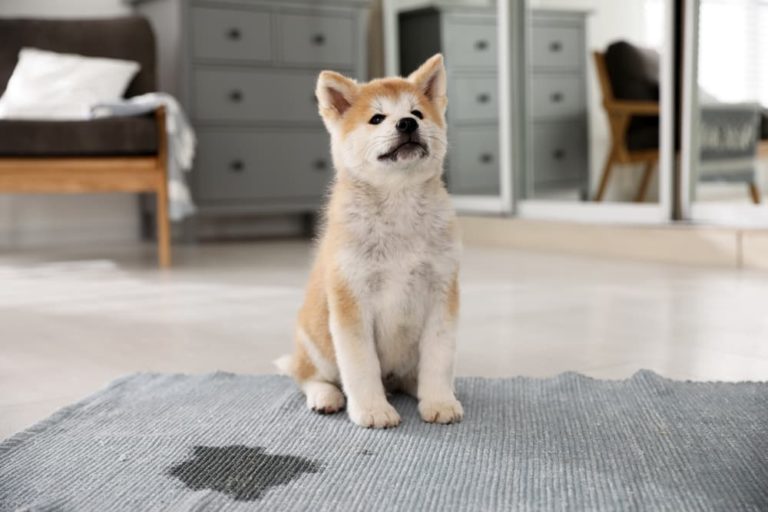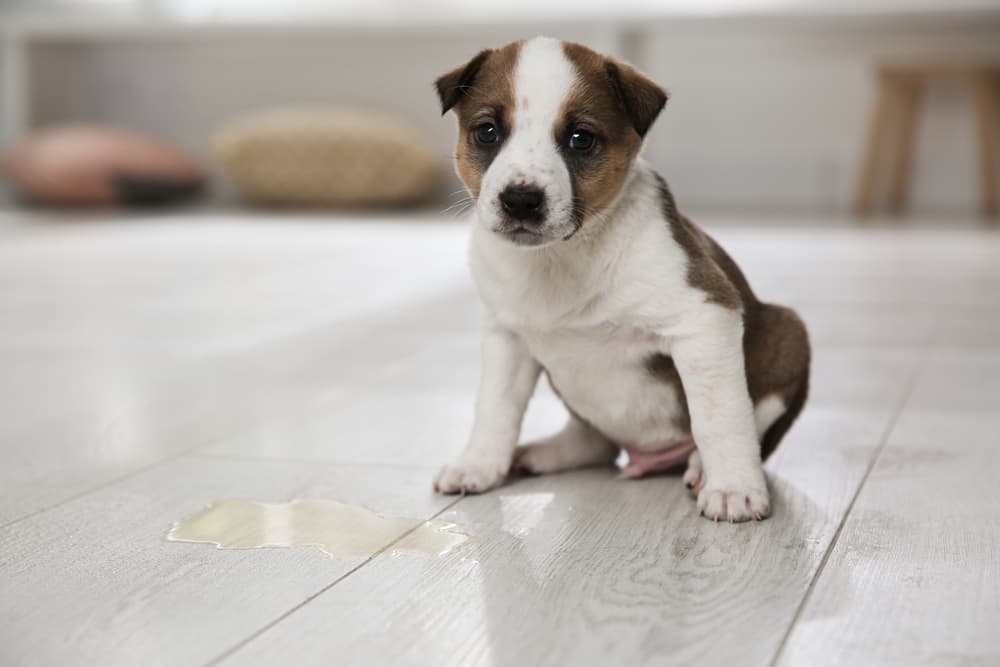Dog Pees When Excited: How to Manage Sprinkling

If your dog pees when excited you know just how challenging the behavior can be. All you want to do is say hello to your best friend and the next thing you know there’s a trail of urine on the floor!
Excitement urination typically happens during highly charged happy scenarios, particularly during greetings and play. While it can be frustrating for pet parents to keep cleaning up, excitement pee can be resolved with a combination of management techniques plus a little time to mature.
Not sure how to teach your dog not to pee when excited? Read on!
Why Do Dogs Pee When Excited?
We might assume that every puddle in the house is a sign of a lapse in potty training, but that’s not the case when it comes to excitement urination.
Keep in mind that a dog that pees when excited is dealing with an involuntary reaction – the pup might be perfectly housetrained in all other scenarios.
It’s a common behavior in puppies because they haven’t fully developed the muscles to control urination, and the good news is that most dogs grow out of the behavior as they get older.
Excitement Urination in Dogs vs Submissive Urination

While excitement urination and submissive peeing might seem like the same thing, the two are related but distinct challenges. Both behaviors can occur in similar scenarios, like when people arrive home, but pet parents should watch their dog’s body language to determine which type of elimination they’re dealing with.
A dog that urinates when excited will probably display other behaviors that convey happiness, like a relaxed face, wiggly body language, and a broadly wagging tail.
Dogs displaying submissive urination often look nervous or uncomfortable. They might lower themselves to the ground, keeping the tail tucked against the body, flatten their ears, lick their lips frequently, or even roll over onto the back as they eliminate. In the dog world this type of body language is a way to appease higher ranking individuals.
How to Stop a Dog From Peeing When Excited
Wondering how to stop excitement urination in dogs? The first step, before attempting training, is to schedule an appointment at the veterinarian to rule out any health issues, like a UTI. Once you’ve gotten an “all clear” try the following tips to help treat excitement peeing.
Keep greetings low key. Of course you’re excited to greet your best friend when you arrive home, but over-the-top hellos can lead to leaks. Rather than making a big deal about your reunion with a loud, happy voice and lots of petting, try letting your dog greet you while maintaining a mellow vibe. Refraining from reaching out to touch your dog can help as well.
Consider moving greetings outside. You won’t have to worry about cleaning your throw rugs when you say hello on the sidewalk or grass. However, keep in mind that if you have to leash your dog in order to safely greet outdoors, the act of leaning over your dog to put the leash on might trigger urination. If an unleashed outside greeting isn’t possible, keep your reunions indoors but roll up the rugs until your pup has a little more bladder control.
Watch your body language. We don’t always realize how our nonverbal communication impacts our dog’s behaviors. For example, reaching over your pup and giving exuberant pats on the head and back might seem like a wonderful way to say howdy, but it could be more excitement than your dog can handle without accidentally dribbling. Instead, try squatting down facing away from your dog and gently petting your dog’s shoulders or side.
Tone down the volume. Related to body language, our voices can amp up our dog’s excitement as well. Rather than using a high pitch or booming voice during greeting, keep your tone low and soft.
Redirect with treats or toys. Giving your dog a “job” can help shift the focus during a greeting. A toy-driven dog might appreciate the chance to latch onto a stuffie, and a treat-driven dog might enjoy scooping up a handful of tiny treats that you’ve tossed onto the floor. However, there’s a fine line between delivering these goodies in a quiet way and turning them into yet another thing to pee about!
Manage guest greetings. Rather than trying to deal with your guests and your peeing pooch at the door, consider putting your pup away as you welcome people into your home and let everyone get settled in before letting your dog out to meet them. Help everyone understand the proper way to interact with your dog to prevent accidental triggers.
In Conclusion

Remember, this behavior is involuntary, meaning your dog can’t control it. That’s why it’s especially important to never punish your dog for excitement urination. Punishment might shift excitement peeing into submissive urination, which adds a layer of complexity to the training process.
If your dog leaves an accidental dribble on the ground the best bet is to avoid making a big deal about it and then clean it with a good pet odor eliminator.
With the right behavioral modification techniques, management, and time, a dog who pees when excited will grow out of the behavior, and you and your best friend will enjoy happy (and dry!) hellos!









